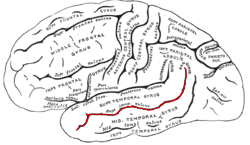Superior temporal sulcus
Superior Temporal Sulcus (STS) is a prominent structure in the human brain located on the surface of the temporal lobe. It is an important area for a variety of complex cognitive functions, including the processing of auditory and speech information, the perception of biological motion, and aspects of social cognition. The STS runs parallel to, and is situated above, the Superior Temporal Gyrus, extending from the area near the temporal pole to the posterior temporal lobe, nearing the parietal lobe.
Anatomy[edit | edit source]
The Superior Temporal Sulcus is part of the cerebral cortex, specifically within the temporal lobe. It divides the Superior Temporal Gyrus from the Middle Temporal Gyrus. The STS is not a uniform structure; its depth and complexity, including branching patterns, can vary significantly between individuals. This variability is thought to reflect the diverse and complex functions the STS supports.
Function[edit | edit source]
The STS is involved in a wide range of neural processes. One of its key roles is in the processing of auditory information, particularly in the comprehension of language. It has been implicated in the perception of phonemes, the smallest units of speech sound that can distinguish one word from another in a particular language.
Beyond auditory processing, the STS has a critical role in social cognition. It is active during the perception of biological motion, such as when interpreting body language and facial expressions. This function is crucial for social interactions, as it helps individuals understand and predict others' actions and intentions. The STS is also involved in Theory of Mind (ToM), the ability to attribute mental states—beliefs, intents, desires, emotions—to oneself and others.
Additionally, the STS has been linked to the processing of visual stimuli, particularly in recognizing faces and expressions. This suggests that the STS serves as an integration point for multimodal information, combining auditory, visual, and possibly even tactile inputs to create a comprehensive understanding of social cues.
Clinical Significance[edit | edit source]
Abnormalities in the structure or function of the STS have been associated with several neurological and psychiatric conditions. For example, individuals with autism spectrum disorder (ASD) often show atypical activity in the STS during tasks involving social cognition, which may contribute to the social and communication difficulties characteristic of ASD. Similarly, alterations in STS function have been observed in schizophrenia, particularly in relation to auditory hallucinations and impaired social functioning.
Research Methods[edit | edit source]
Investigations into the function of the STS typically employ a variety of neuroimaging techniques, including functional magnetic resonance imaging (fMRI) and positron emission tomography (PET). These methods allow researchers to observe the activity of the STS in real-time, during the performance of specific tasks or in response to particular stimuli.
Conclusion[edit | edit source]
The Superior Temporal Sulcus plays a critical role in the human brain's processing of auditory, visual, and social information. Its involvement in such a wide range of cognitive functions makes it a focal point of interest in neuroscience, particularly in studies related to language comprehension, social interaction, and the neural basis of psychiatric conditions.
This article is a neuroscience stub. You can help WikiMD by expanding it!
Search WikiMD
Ad.Tired of being Overweight? Try W8MD's physician weight loss program.
Semaglutide (Ozempic / Wegovy and Tirzepatide (Mounjaro / Zepbound) available.
Advertise on WikiMD
|
WikiMD's Wellness Encyclopedia |
| Let Food Be Thy Medicine Medicine Thy Food - Hippocrates |
Translate this page: - East Asian
中文,
日本,
한국어,
South Asian
हिन्दी,
தமிழ்,
తెలుగు,
Urdu,
ಕನ್ನಡ,
Southeast Asian
Indonesian,
Vietnamese,
Thai,
မြန်မာဘာသာ,
বাংলা
European
español,
Deutsch,
français,
Greek,
português do Brasil,
polski,
română,
русский,
Nederlands,
norsk,
svenska,
suomi,
Italian
Middle Eastern & African
عربى,
Turkish,
Persian,
Hebrew,
Afrikaans,
isiZulu,
Kiswahili,
Other
Bulgarian,
Hungarian,
Czech,
Swedish,
മലയാളം,
मराठी,
ਪੰਜਾਬੀ,
ગુજરાતી,
Portuguese,
Ukrainian
Medical Disclaimer: WikiMD is not a substitute for professional medical advice. The information on WikiMD is provided as an information resource only, may be incorrect, outdated or misleading, and is not to be used or relied on for any diagnostic or treatment purposes. Please consult your health care provider before making any healthcare decisions or for guidance about a specific medical condition. WikiMD expressly disclaims responsibility, and shall have no liability, for any damages, loss, injury, or liability whatsoever suffered as a result of your reliance on the information contained in this site. By visiting this site you agree to the foregoing terms and conditions, which may from time to time be changed or supplemented by WikiMD. If you do not agree to the foregoing terms and conditions, you should not enter or use this site. See full disclaimer.
Credits:Most images are courtesy of Wikimedia commons, and templates, categories Wikipedia, licensed under CC BY SA or similar.
Contributors: Prab R. Tumpati, MD

